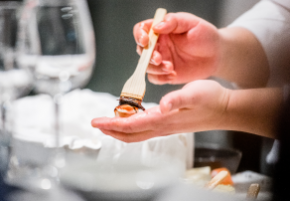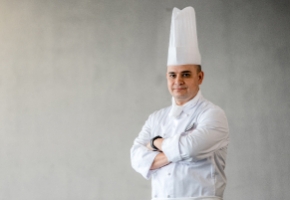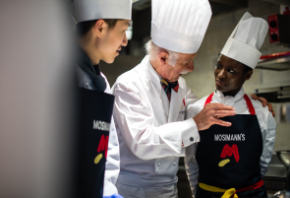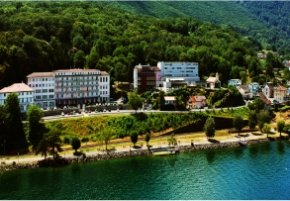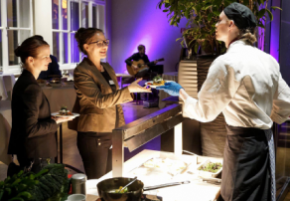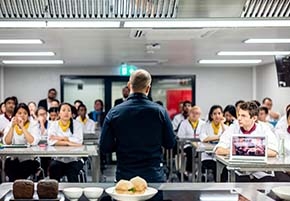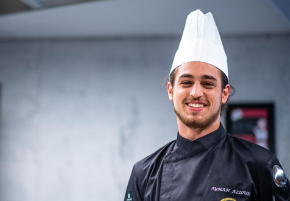- About
- Programs
- Campus Life
- Career Services
- Admissions
- News & Events
- Alumni
Chocolate Making Process: From Bean to Bar
Uncover the secrets of the chocolate making process. From cocoa cultivation to tempering, learn how chocolate is crafted for the perfect taste and texture.
Key Takeaways
- The chocolate-making process includes multiple steps—from harvesting the cocoa pods to fermenting, roasting, refining, tempering, molding, and then storing the final product.
- Tools needed to make chocolate include roasters, grinders, melangers, tempering machines, molds, and thermometers.
- The future of chocolate is being shaped by sustainability, climate change, new technology, and alternative ingredients, all driving more ethical, eco-friendly, and high-quality production.
The history of chocolate stretches back thousands of years. Early on, it was the sweet pulp of the cacao fruit that was consumed, but over time, people discovered how to roast the bitter seeds, unlocking a new culinary treasure. Cacao beans became so priced that they were once used as currency.
Today, through harvesting, roasting, grinding, and refining, those once-bitter beans are transformed into everything from classic chocolate bars to truffles, ganache-filled bonbons, and even intricate chocolate sculptures.
Switzerland, though not the birthplace of chocolate, has become one of its most celebrated homes, renowned for setting global standards of quality. At Culinary Arts Academy Switzerland (CAAS), students carry that tradition forward by mastering the art of fine pastry and working with Swiss chocolate.
Key Steps of the Chocolate Making Process
The process of making chocolate requires both technical knowledge and a refined touch. As CAAS alumna Akshay Ravindra Babu, a former engineer turned chocolatier, puts it, "These days, people have whipping cream accessible to them. But to make it stable for a long period of time, it comes with a bit of education. Having that education gave me a faster approach to things."
The same applies to working with chocolate. Knowing how and why each step works—from tempering to molding—makes the process easier to understand and far more reliable. Mastering chocolate isn’t just about following instructions; it’s about developing the instincts and confidence that come from hands-on experience.
1. Cultivating and harvesting the cocoa
Theobroma cacao is a tree from the Malvaceae family whose seeds—cacao beans—are used to make chocolate. Such trees require warm temperatures, high humidity, and fertile, well-draining soil to grow, making countries in West Africa, Central and South America, and Southeast Asia major producers.
Cocoa trees produce pods that grow directly from the trunk and main branches. These pods take several months to ripen, turning yellow, orange, red, or purple, depending on the variety. Inside each pod, there are typically 30 to 50 beans surrounded by a sugary pulp.
Harvesting cacao is usually a more hands-on process. Workers use long-handled knives or machetes to carefully cut the ripe pods from the tree without damaging the trunk or nearby undeveloped buds. It’s a labor-intensive but essential step, as the machines could damage the pods or harm the plant.
Timing is also crucial. Harvesting pods too early can lead to flat, underdeveloped flavors, while overripe pods increase the risk of fermentation problems or spoilage.
2. Fermenting and drying
After harvesting, the beans and surrounding pulp are removed from the pods and placed in boxes, baskets, or heaped banana leaves to ferment. This natural process takes about five to seven days, during which yeasts and bacteria break down the pulp and initiate fermentation.
Without fermentation, the beans would retain a raw, bitter, and grassy flavor. Instead, this step reduces astringency and begins developing the complex aromas that define good chocolate, ranging from fruity and nutty to floral or even wine-like flavors.
Once fermentation is complete, the beans must be thoroughly dried to halt microbial activity and prevent mold. This is typically done under the sun on raised mats or drying tables, though mechanical dryers are sometimes used in areas with unpredictable weather.
3. Roasting the cocoa beans
After the drying process, the beans are shipped to chocolate makers for roasting, which removes any remaining moisture and deepens the flavor.
Roasting time and temperature are very important—If the process is too short or too cool, the beans can develop an overly sour taste; too long or too hot, and the chocolate may taste burnt or flat. That is why the temperature and duration are adjusted based on the bean variety and the desired final product.
For example, delicate beans used for high-end dark chocolate are typically roasted at lower temperatures for longer periods to preserve subtle flavor notes. Milk chocolate, however, requires a gentler roast to maintain its creamy character, while white chocolate doesn't undergo this step at all since it doesn't contain cocoa solids.
4. Cracking and winnowing
Next, the brittle beans are cracked open to reveal the cocoa nibs that will eventually become chocolate. The outer husk, however, is inedible and must be removed.
This leads to the winnowing process, where airflow is used to separate the lighter husks from the heavier nibs. Though quite simple, it's a critical step for ensuring high quality, as any remaining husk fragments can affect the final product's texture and taste, making it gritty or unpleasant.
5. Grinding and conching
The winnowed nibs are then ground into a thick, gritty paste known as chocolate liquor—named not because it contains alcohol but because it flows like a liquid when warm. This paste naturally contains both cocoa solids, which give chocolate its flavor, as well as cocoa butter.
At this point, it's normal for the texture to still be coarse, so the chocolate is sent into a conching machine, where it's kneaded, aerated, and gently heated—often for hours or even days. This way, the texture is improved, and any unwanted acidic or bitter notes are evaporated, resulting in a smoother consistency and more balanced flavor.
6. Tempering the chocolate
Tempering is the process of heating, cooling, and reheating chocolate to form stable cocoa butter crystals. When done properly, it gives the chocolate a glossy finish, a satisfying snap when broken, and a smooth, melt-in-your-mouth texture.
There are several ways to temper chocolate: one of the oldest involves using a marble slab to cool the chocolate by hand. However, nowadays, modern chocolatiers may also use digital tempering machines.
Regardless of the method, the goal is to align the cocoa butter crystals in just the right way. If skipped or done incorrectly, the chocolate may turn out dull, streaky, soft, or riddled with white patches known as bloom. Though still edible, untempered chocolate lacks the professional finish and shelf stability that great chocolate is known for.
7. Molding and cooling
The tempered liquid chocolate is then given shape by pouring it into molds of all kinds, like bars, bonbons, coins, or novelty shapes, gently shaken to remove air bubbles, and left to cool.
Even the cooling requires care and strategy since if chocolate cools too quickly or unevenly, it may contract improperly or develop imperfections on the surface, and if cooled too slowly, it might not set at all. Typically, the chocolate is left to cool at controlled room temperatures or in specialized cooling cabinets until it hardens and cleanly separates from the mold.
8. Packaging and storing
The final—but far from minor—step is packaging and storage. Chocolate is highly sensitive to heat, humidity, and light, all of which can dull its flavor and appearance. Therefore, proper packaging can be the protective barrier that helps preserve the balance of texture and taste developed through the earlier steps. Foil, wax paper, or food-safe plastics are commonly used, often paired with elegant outer wrappers or boxes.
Once packaged, chocolate should be stored at around 16–18°C (60–65°F) in a dry, odor-free environment. Storing it in the fridge is not ideal, as it can cause sugar to bloom when moisture condenses on the surface. Similarly, warmer conditions than the ones suggested may lead to fat bloom, where the cocoa butter rises and creates a dusty, whitish film.
Although these findings do not render the chocolate unfit for consumption, they impact its texture and appearance, changing its intended flavor.
Essential Equipment for Chocolate Making
The right tools can make each of the steps that go into making chocolate much easier. Some such tools include:
- Sorting tray to pick out bad beans and any debris before roasting
- Roaster or oven to roast the beans and bring out the chocolate flavor
- Rolling pin or cocoa mill to break the beans into small pieces after roasting
- Winnower (or hair dryer and bowl) to blow away the outer shells
- Grinder or mélanger to grind the nibs into a smooth paste
- Conching machine to mix and smooth the chocolate
- Pre-grinder, like a blender or food processor, to speed up the grinding process
- Marble slab to temper the chocolate
- Thermometer to track temperatures while roasting and tempering
- Molds to shape your chocolate
- Cooling rack or cabinet to cool the chocolate evenly
- Spatula or scraper to stir, scrape, and spread chocolate
- Double boiler or heat gun to melt or warm chocolate without burning it
- Airtight storage containers to keep the chocolate fresh and protected from heat or moisture
How the Chocolate Making Process Differs by Chocolate Type
It's hard to find someone who doesn't like chocolate—mainly because chocolate comes in so many different forms. From rich and bitter to sweet and creamy, from glossy bars to melt-in-your-mouth truffles, there's a type of chocolate to satisfy nearly every palate. This variety isn't just about flavor—it also comes down to how different types of chocolate are made.
Each type of chocolate follows the same broad process, but the ingredients, timing, and techniques are fine-tuned to bring out the best possible taste and texture. The following are three of the most common types:
Dark chocolate
- Made with cocoa liquor, cocoa butter, and sugar, without added milk solids.
- Usually has the highest percentage of cocoa.
- Refining and conching time is often longer to develop the bold flavor.
- Tempering must be done with extra care and precision to maintain its firm snap and glossy finish, as there's no milk fat to soften the structure.
Milk chocolate
- Includes milk solids or milk powder along with cocoa liquor, cocoa butter, and sugar.
- Requires additional care in balancing the cocoa-to-milk ratio to avoid overpowering or dulling the flavor.
- Tempering is slightly more forgiving due to the milk fat, which softens the texture and adds creaminess.
White chocolate
- Contains no cocoa solids—only cocoa butter, sugar, and milk solids.
- Requires high-quality cocoa butter for flavor since there are no cocoa solids.
- Easily overheats during refining and tempering, so temperature control is critical to prevent burning or separating.
The Future of Chocolate Making
Chocolate isn't going anywhere; if anything, the demand for premium products is growing. That means the practice of chocolate making will only become more important in the years ahead.
As consumer expectations around chocolate shift, so do the ideas, techniques, and innovations driving the chocolate-making industry forward. Some of the trends shaping both its present and likely its future include:
- Sustainable cocoa farming: It supports fair wages, reduces child labor, and encourages environmentally friendly farming practices. The so-called "bean-to-bar movement" reinforces these goals by focusing on ethical sourcing, direct trade relationships, and full transparency from origin to finished product.
- Alternative ingredients: These include especially dairy-free, sugar-free, or plant-based chocolate products made with oat milk, coconut sugar, or even avocado.
- Technology and AI: They are used for flavor profiling and automated refining machines that help improve consistency and creativity throughout the production process.
- Climate change awareness: Climate change is already disrupting cacao production in West Africa, where about 70% of the world's supply is grown, by altering rainfall and temperatures, reducing yields and quality, and driving up prices.
The Art and Precision Behind Every Chocolate Bar
From bean to bar, every step in the chocolate-making process matters. In Switzerland, the world leader in annual per capita chocolate consumption, this attention to detail is taken especially seriously. As CAAS student Bader Najeeb put it:
Switzerland is by far the best place in the world to study chocolate!
But studying chocolate doesn't mean only focusing on its production. Once chocolate is made, there's a whole world of possibilities in what you can create with it.
That creative side is something we at CAAS nurture through our programs like the Swiss Diploma in Pastry Arts and even through our broader BA in Culinary Arts program. We also give students access to world-class expertise through our teaching staff as well as guest chefs in our Distinguished Chef Series.
Therefore, if you're serious about learning, exploring, and creating with chocolate, CAAS is the sweetest place to start.
Frequently Asked Questions
What are the main ingredients in chocolate?
The main ingredients include cocoa beans, cocoa butter, sugar, and sometimes milk solids and flavorings like vanilla.
How long does it take to make chocolate from scratch?
If you begin with dried cocoa beans and the right tools, the process usually takes 2 to 3 days. Starting from fresh cacao pods adds more time, with fermentation and drying alone taking over a week, making the full timeline closer to 2 to 3 weeks.
What is the difference between cocoa and cacao?
"Cacao" refers to the raw beans in an unprocessed form, while "cocoa" typically refers to the roasted, processed version used in chocolate products.
Interested in learning pastry arts? Discover our Swiss Diploma in Pastry Arts program.
